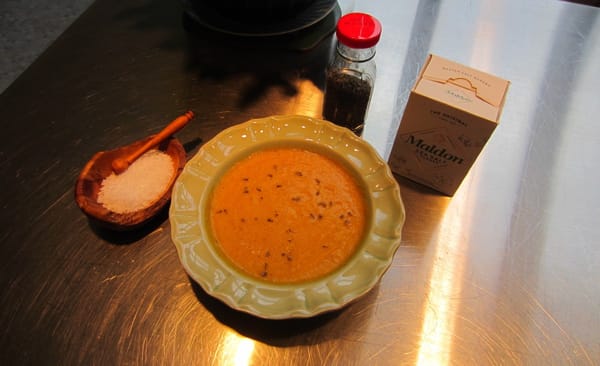Recipe: Melon Soup
A not-sweet fruit soup that's been handed down from French neighbors to friend to Pamela Osborne.

A not-sweet fruit soup that's been handed down from French neighbors to friend to Pamela Osborne.

About our new recipe contributor: Pamela Osborne moved to Salisbury, Connecticut in 1997, and it has taken this long to renovate what was her disaster of a house. Before that, she had renovated and sold several houses and apartments in Westchester County and New York City. She is a graduate of the University of Michigan, where she picked up some things to think about when she was stripping and sanding woodwork. Her family seemed to expect meals to appear, and so to keep that from becoming a total chore and bore she learned how to do it better over time. Many of her favorite memories and moments are centered around sharing meals with friends, and long hours spent talking with them at the table. Not surprisingly, a lot of the conversation is about how lucky we are to live in the beautiful Rural Intelligence region. We are happy to welcome Pamela and her occasional recipe contributions.
This very unusual recipe was given to me by a friend, Georgeanne Brennan, who wrote many of the Williams Sonoma cookbooks and many of her own as well. Georgeanne left the United States during the Vietnam War, and lived in a small village in the Var region of the south of France for several years. Her wonderful book, A Pig in Provence, tells of the life she lived there with her then-husband and, eventually, their two small children. The village people were very welcoming and helpful, and I believe this recipe came from one of them. Georgeanne lives in California now, but she has kept her house in France and travels there as often as she can.
Unlike many fruit soups, this is not sweet. It’s a good way to keep some of summer stowed in the freezer for a cold winter day and, like Peas Porridge Pot, it’s good both hot and cold. The flavor is a complete surprise, and of course the quality of the melons used will affect the outcome. I made this latest batch with two small melons from a farmers market and one from the Stop and Shop that had ripened on the counter for a few days. (The Stop and Shop melon was better, go figure.) Part of the unique flavor comes from using dried lavender flowers — they add a lot, but aren’t absolutely necessary.
I always hold back a bit when adding salt; you can always correct later. I’ve tried a lot of sea salts, but my favorite is Maldon from England, a flaky white salt you crumble over food with your fingers. Once you’ve tried it you’ll never go back.
The amounts given below are for a basic recipe. I usually triple it so I can freeze it, but you may want to try it out first. But do try it, you won’t be sorry!
Melon Soup
Makes 2 generous servings
1- 2 melons (I use orange melons, but Georgeanne says honeydews are good, too. When cut into about 1 to 1-12 inch chunks, you want four to five cups.)
1/4 cup chopped onions — red, yellow, or shallots
1 and 1/2 Tbls. extra virgin olive oil. (Lately I’ve been using Olive Oil Jones, ordered online.)
1/2 to 1 tsp. sea salt
1 tsp. freshly ground pepper
1 and 1/2 tsp dried lavender, divided, if you have it
Cube the melon, put in a pot on low heat, stir once in a while.
Meanwhile, heat the oil, sauté the onions until soft. When they are, add them and the oil, the salt and pepper, and half the lavender to the melon. Cook the mix over medium heat, stirring occasionally so that it cooks evenly, until the melon has softened somewhat, about 5 minutes or so.
Reduce the heat to low, cover, and cook until very soft. Depending on the melon, this can take from 10 to 15 minutes to half an hour. (I was making a big pot, so it t ook the longer time, and I let it sit with the heat off and lid on for a while after.) You want the melon to be quite soft, but not a mush.
Puree this with an immerson blender if you have one, or ladle into a blender and use that if you don’t. It should be very smooth. Serve hot or cold, with sprinkled lavender and salt to add on the side. Keeps in the freezer until fresh melon season comes around again.